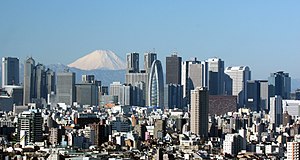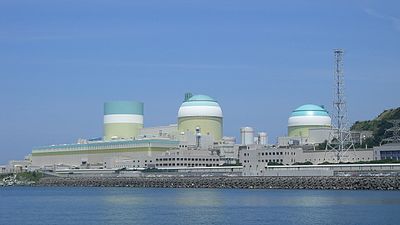Japan
| Japan | |||||
|---|---|---|---|---|---|
| |||||
| Des ke jaankari | |||||
| Des ke motto: | n/a | ||||
| National anthem: | Kimi Ga Yo | ||||
| Log ke baare me | |||||
| Official bhasa: | Japanese 日本語 | ||||
| Abaadi: | |||||
| - Total: | {{{populationtotal}}} | ||||
| Jagha | |||||
 | |||||
| Capital City: | Tokyo | ||||
| Sab se barraa City: | Tokyo | ||||
| Area | |||||
| - Total: | 377,835 (ranked 60) | ||||
| - Water: | 3,091 km² (0.8%) | ||||
| Politics / Government | |||||
| Established: | According to legend, February 11, 660 BC | ||||
| Leader: | Emperor Naruhito Prime Minister Fumio Kishida | ||||
| Economy / Money | |||||
| Paisa ke naam: | Yen (JPY) | ||||
| International information | |||||
| Time ke zone: | +09:00 | ||||
| Telephone ke dialing code: | 81 | ||||
| Internet domain: | .jp | ||||
Japan (日本), Asia ke ek des hae. Isme dher island hae, jisme se chaar barraa island hae, jiske naam Honshu, Hokkaido, Shikoku, aur Kyushu hae.
Japan ke log aapan des ke "Nihon" nai to "Nippon" bole hae, jiske matlab Japanese bhasa me "the origin of the sun" hae .
Japan me chaar barraa 3,000 chhota chotaa island hae. Japan, Asian continent se Sea of Japan aur East China Sea se separated hae.

Japan ke biich me pahaarr hae aur isme dher volcano hae Japan me dher earthquake aaawe hae.
Japan ke 90% log 10%jamiin me samundar ke nachdik rahe hae.
Japan me 10 cities ke abaadi, ek million people se jaada hae. Japan ke capital aur sab se barraa city Tokyo hae.
Itihaas
[badlo | source ke badlo]=Puraana itihaas
[badlo | source ke badlo]
Insaan, Japan me 38,000 saal pahile aae rahin.[1] Iske baad 14,500 BC me Japan me hunter-gatherer culture rahaa. Ii time ke clay ke pottery dunia me sab se purana pottery hae.[2] [3]700BC talak Japonic bhasa me baat kare waale Yayoi log Koea ke aain aur Jomon log ke saathe rahe lagin.[4] Ii time dhaan ke kheti suruu bhais aur nawaa rakam ke pottery ke banaawa gais, aur China aur Korea se dhaatue ke upyog ke Japan me hoe agaa.[5] Ii time, 660BC me Emporer Jimmu ek Raj ke suruu karis, jon ki imperial Japan ke suruu rahaa.[6]
Japan ke naam pahila dafe China ke itihaas me me "Book of Han"" me karaa jaae hae, jon ki 111 AD. me likha gais rahaa. Buddhism ke Japan me Korea se laawa gais rahaa, lekin Japan ke Busshism pe sab se jaada asar China se rahaa.[7] Suruu me kuchh baadha ke bawajuut, Japan ke ruling class Buddhism ke promote karis rahaa. [8] 645 me Japan ke Emporer, des me dher reform ke suruu karis, jon ki jamiin pe control [[Confuius ke bichaar pe rahaa. [9] It nationalized all land in Japan, to be distributed equally among cultivators, and ordered the compilation of a household registry as the basis for a new system of taxation.[10] Log ke China bheja gais rahaa,jisse ki China se writing, politics, arts aur dharam ke baare me sikhe sake.[9] 672 me dui prince ke biich me Jinshin War ke baad Japan me dher administrative reform karaa gais.[11] Ii sab reform ke baad, Japan me China ke rakam centralized sarkar banaawa gais rahaa.[11]
784 me Japan ke capital ke Kyoto me kar dewa gais.[12] Is ke baad Heian period (794-1185) suruu bhais aur ek distinct Japan ke snakriti suruu bhais. Ii time me The Tale of Genji aur Japan ke national anthem ke lokha gais rahaa.[13]
=Feudal era
[badlo | source ke badlo]

Japan ke feudal era me samurai log sarkar ke dominate kare lagin. [14] 1185 me jab Minamoto clan, Taira clan ke ek larrai me harae diis tab samurai Minamoto no Yoritomo kamakura me ek military sarkar suruu karis.[15] Yoritomo ke maut ke baad, Hojo clan power me aais. Kamakura period (1185-1333) me Zen Buddhism ke China se Japan me laawa gais rahaa.[16] Kamakura shogunate, jon ki 1274 se 1281 talak raj karis, Japan ke Mongol invasion se bachais, lekin isk Emporer Go-Daigo harae ke Emporer banaa. Go-Daigo ke Ashikaga Takauji harais, 1336 me aur Muromachi period (1336-1573) suruu bhais.[17] Baad ke Ashikaga shogunate feudal warlords ke kaabu me nai rakkhae paais aur 1467 me civil war suruu hoe gais.[18]
16th century me Portuguese traders aur Jesuist missionaries japan pahuchin aur japan aur west ke biich me contact suruu bhais.[19] Oda Nobunaga Europe ke technology aur banduuk ke kaam me laae ke aapan control barrhais.[20] Iske baad Azuchi-Momoyama period suruu bhais.[21]
Chapa ke gallery
[badlo | source ke badlo]-
Mongol invasion kerepel kar dewa gais rahaa
-
Japan ke laal seal jahaaj
-
1867 ke Boshin larrai
-
Tokyo ke skyscrapers
-
Osaka
-
Nuclear Power Plant
-
Tokyo Stock Exchange
References
[badlo | source ke badlo]- ↑ Kondo, Y.; Takeshita, Y.; Watanabe, T.; Seki, M.; Nojiri-ko Excavation Research Group (April 2018). "Geology and Quaternary environments of the Tategahana Paleolithic site in Nojiri-ko (Lake Nojiri), Nagano, central Japan" (in en). Quaternary International 471: 385–395. doi:10.1016/j.quaint.2017.12.012. https://linkinghub.elsevier.com/retrieve/pii/S1040618217300307.
- ↑ Habu, Junko (2004). Ancient Jomon of Japan. Cambridge University Press. p. 43. ISBN 978-0-521-77670-7. https://books.google.com/books?id=vGnAbTyTynsC&pg=PA43.
- ↑ "Jōmon Culture (ca. 10,500–ca. 300 B.C.)". Metropolitan Museum of Art. Archived from the original on December 13, 2021. Retrieved August 28, 2020.
- ↑ Wade, Nicholas. "Finding on Dialects Casts New Light on the Origins of the Japanese People", The New York Times, May 4, 2011.
- ↑ "Yayoi Culture (ca. 300 B.C.–300 A.D.)". Metropolitan Museum of Art. Archived from the original on January 4, 2020. Retrieved July 21, 2024.
- ↑ Hendry, Joy (2012). Understanding Japanese Society. Routledge. p. 9. ISBN 978-1-136-27918-8. https://archive.org/details/understandingjap00hend.
- ↑ Brown, Delmer M.; Hall, John Whitney; Jansen, Marius B.; Shively, Donald H.; Twitchett, Denis (1988). The Cambridge History of Japan. 1. Cambridge University Press. pp. 140–149, 275. ISBN 978-0-521-22352-2. https://books.google.com/books?id=A3_6lp8IOK8C&pg=PA141.
- ↑ Beasley, William Gerald (1999). The Japanese Experience: A Short History of Japan. University of California Press. p. 42. ISBN 978-0-520-22560-2. https://books.google.com/books?id=9AivK7yMICgC&pg=PA42.
- ↑ 9.0 9.1 Totman, Conrad (2005). A History of Japan (2nd ed.). Blackwell. p. 72. ISBN 978-1-4051-2359-4. https://books.google.com/books?id=Z_a_QgAACAAJ.
- ↑ Cite error: Invalid
<ref>tag; no text was provided for refs namedSansom - ↑ 11.0 11.1 Totman, Conrad (2002). A History of Japan. Blackwell. pp. 107–108. ISBN 978-1-4051-2359-4. https://books.google.com/books?id=Z_a_QgAACAAJ.
- ↑ Cite error: Invalid
<ref>tag; no text was provided for refs namedCourtiers - ↑ Totman, Conrad (2002). A History of Japan. Blackwell. pp. 79–87, 122–123. ISBN 978-1-4051-2359-4. https://books.google.com/books?id=Z_a_QgAACAAJ.
- ↑ Leibo, Steven A. (2015). East and Southeast Asia 2015–2016. Rowman & Littlefield Publishers. pp. 99–104. ISBN 978-1-4758-1875-8. https://books.google.com/books?id=1yX-CQAAQBAJ&pg=PA99.
- ↑ Middleton, John (2015). World Monarchies and Dynasties. Routledge. p. 616.
- ↑ Totman, Conrad (2005). A History of Japan (2nd ed.). Blackwell. pp. 106–112. ISBN 978-1-4051-2359-4. https://books.google.com/books?id=Z_a_QgAACAAJ.
- ↑ Shirane, Haruo (2012). Traditional Japanese Literature: An Anthology, Beginnings to 1600. Columbia University Press. p. 409. ISBN 978-0-231-15730-8. https://books.google.com/books?id=E8qq6zhhM5kC&pg=PA409.
- ↑ Sansom, George (1961). [[[:Template:Google books]] A History of Japan: 1334–1615]. Stanford University Press. pp. 42, 217. ISBN 978-0-8047-0525-7. Template:Google books.
- ↑ Lidin, Olof (2005). Tanegashima. Taylor & Francis. ISBN 0-203-47957-2.
- ↑ Brown, Delmer (May 1948). "The impact of firearms on Japanese warfare, 1543–98". The Far Eastern Quarterly 7 (3): 236–253. doi:10.2307/2048846.
- ↑ "Azuchi-Momoyama period (1573–1603)". Dallas Museum of Art. Archived from the original on November 6, 2020. Retrieved October 3, 2020.









